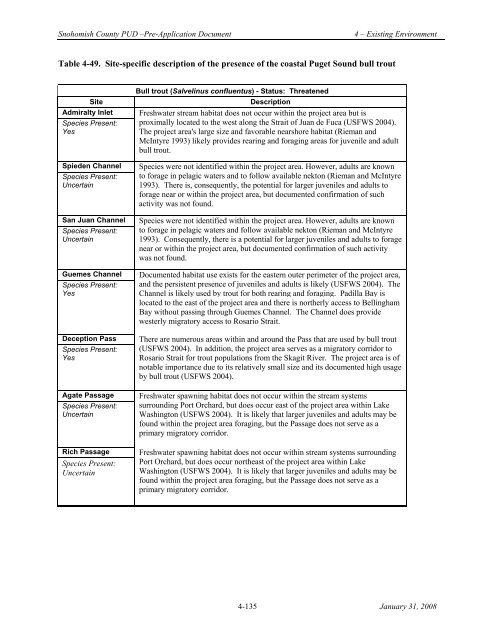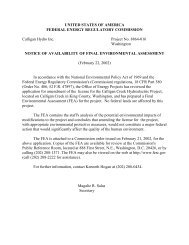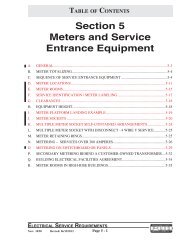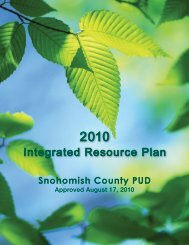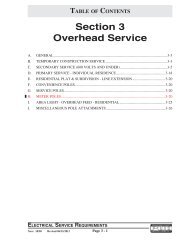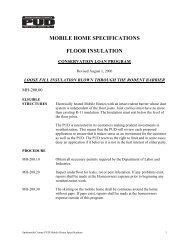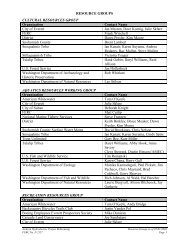Tidal_PAD_V1_Sec4.pdf - Snohomish County PUD
Tidal_PAD_V1_Sec4.pdf - Snohomish County PUD
Tidal_PAD_V1_Sec4.pdf - Snohomish County PUD
Create successful ePaper yourself
Turn your PDF publications into a flip-book with our unique Google optimized e-Paper software.
<strong>Snohomish</strong> <strong>County</strong> <strong>PUD</strong> –Pre-Application Document<br />
4 – Existing Environment<br />
Table 4-49. Site-specific description of the presence of the coastal Puget Sound bull trout<br />
Site<br />
Admiralty Inlet<br />
Species Present:<br />
Yes<br />
Spieden Channel<br />
Species Present:<br />
Uncertain<br />
San Juan Channel<br />
Species Present:<br />
Uncertain<br />
Guemes Channel<br />
Species Present:<br />
Yes<br />
Deception Pass<br />
Species Present:<br />
Yes<br />
Agate Passage<br />
Species Present:<br />
Uncertain<br />
Rich Passage<br />
Species Present:<br />
Uncertain<br />
Bull trout (Salvelinus confluentus) - Status: Threatened<br />
Description<br />
Freshwater stream habitat does not occur within the project area but is<br />
proximally located to the west along the Strait of Juan de Fuca (USFWS 2004).<br />
The project area's large size and favorable nearshore habitat (Rieman and<br />
McIntyre 1993) likely provides rearing and foraging areas for juvenile and adult<br />
bull trout.<br />
Species were not identified within the project area. However, adults are known<br />
to forage in pelagic waters and to follow available nekton (Rieman and McIntyre<br />
1993). There is, consequently, the potential for larger juveniles and adults to<br />
forage near or within the project area, but documented confirmation of such<br />
activity was not found.<br />
Species were not identified within the project area. However, adults are known<br />
to forage in pelagic waters and follow available nekton (Rieman and McIntyre<br />
1993). Consequently, there is a potential for larger juveniles and adults to forage<br />
near or within the project area, but documented confirmation of such activity<br />
was not found.<br />
Documented habitat use exists for the eastern outer perimeter of the project area,<br />
and the persistent presence of juveniles and adults is likely (USFWS 2004). The<br />
Channel is likely used by trout for both rearing and foraging. Padilla Bay is<br />
located to the east of the project area and there is northerly access to Bellingham<br />
Bay without passing through Guemes Channel. The Channel does provide<br />
westerly migratory access to Rosario Strait.<br />
There are numerous areas within and around the Pass that are used by bull trout<br />
(USFWS 2004). In addition, the project area serves as a migratory corridor to<br />
Rosario Strait for trout populations from the Skagit River. The project area is of<br />
notable importance due to its relatively small size and its documented high usage<br />
by bull trout (USFWS 2004).<br />
Freshwater spawning habitat does not occur within the stream systems<br />
surrounding Port Orchard, but does occur east of the project area within Lake<br />
Washington (USFWS 2004). It is likely that larger juveniles and adults may be<br />
found within the project area foraging, but the Passage does not serve as a<br />
primary migratory corridor.<br />
Freshwater spawning habitat does not occur within stream systems surrounding<br />
Port Orchard, but does occur northeast of the project area within Lake<br />
Washington (USFWS 2004). It is likely that larger juveniles and adults may be<br />
found within the project area foraging, but the Passage does not serve as a<br />
primary migratory corridor.<br />
4-135 January 31, 2008


